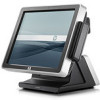HP ap5000 Quick Setup & Getting Started HP ap5000 All-In-One Point of Sale - Page 22
Turning Off the Computer, Finding More Information, Accessing the User Guides - specifications
 |
View all HP ap5000 manuals
Add to My Manuals
Save this manual to your list of manuals |
Page 22 highlights
4. Enter your product name in the text box and press the Enter key. 5. Select your specific computer model. 6. Select your OS. 7. Select the Diagnostic link. 8. Select the Hewlett-Packard Vision Diagnostics link. 9. Select the Download button. NOTE: The download includes instructions on how to create the bootable CD or the bootable USB flash drive. Turning Off the Computer To properly turn off the computer, first shut down the operating system software. In Windows XP, Windows Embedded POSReady 2009, and Windows 7, select Start > Shut Down. The computer automatically shuts down. Depending on the operating system, pressing the power button may cause the system to enter a lowpower or "standby" state instead of automatically turning the power off. This allows you to conserve energy without closing software applications; later, you can start using the system immediately without having to restart the operating system and without losing any data. CAUTION: Manually forcing the computer off will cause the loss of any unsaved data. To force the computer off manually and bypass the "standby state," press and hold the power button for four seconds. On some models, you can reconfigure the power button to work in On/Off mode by running Computer Setup. Refer to the Maintenance and Service Guide (available in English only) for more information about using the Computer Setup utility. Finding More Information The following publications are available on the computer hard drive or on the web at http://www.hp.com/ support. NOTE: Not all of the publications listed are included on all models. ● Quick Setup & Getting Started (also available in print)-Helps you connect the computer and peripheral devices and set up factory-provided software; also includes basic troubleshooting information should you encounter any problems during initial startup. ● Hardware Reference Guide-Provides an overview of the product hardware, as well as instructions for upgrading, removing, and replacing hardware components. ● Maintenance and Service Guide (English only)-Provides information on parts removal and replacement, troubleshooting, Desktop Management, setup utilities, safety, routine care, connector pin assignments, POST error messages, diagnostic indicator lights and error codes. ● Safety & Regulatory Information Guide-Provides safety and regulatory information that ensures compliance with U.S., Canadian, and various international regulations. Accessing the User Guides HP user guides are available on the hard drive or on the web at http://www.hp.com/support. 16 Quick Setup & Getting Started ENWW













